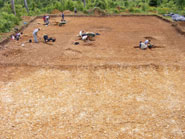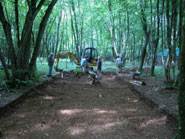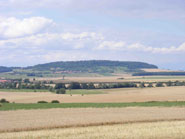The excavations were carried out by Dr Volker Heyd of the University’s Department of Archaeology and Anthropology at the vast 16 hectare site on top of a wooded plateau called Le Haut du Mont overlooking the village of Tincry in central Lorraine.
The hill fort was identified as a pre- and protohistoric site at the end of the nineteenth century – one of more than 200 such forts in Lorraine. However, in the late 1990s, local archaeologists recognised that an immense mound (some 100m in diameter and 8m in height, located just 2.5 km from the hill fort), was one of the largest burial tumuli in Eastern France.
This combination of a hill fort with a large burial mound led to the suspicion that Tincry might be one of the so-called ‘princely sites’ of the Early Iron Age (c. 650-400 BC), of which only 18 are known in the 100,000 square kilometre area of Central France, Western Germany and parts of Switzerland.
These ‘princely sites’ are regarded as regional centres of power and played a key role in trade and communication with the classical societies of the Mediterranean, contributing to the formation of the Celts.
The excavations, carried out between 2006 and 2009, revealed that the earliest Iron Age settlement on the plateau was unenclosed while later phases saw the construction of massive fortifications surrounding a permanent settlement.
The ramparts were dismantled and the defensive ditch filled in around 400 BC, with no evidence of a violent destruction. A large quantity of pottery and metal finds were discovered.
During each excavation campaign surveys were also conducted. These verified the existence of more than 400 contemporary burial mounds organized in multiple necropoles (cities of the dead) on the wooded hills within a 20 kilometre radius of the hill fort. Ten larger tumuli that, potentially, can be called ‘princely’ due to their large size, height and prominent position, have also been located.
Dr Heyd said: “This long-term Bristol research project is now entering its next funded period. Further excavations will target specific questions in the following years, such as the organisation of the early Celtic occupation in the hill fort itself in relation to satellite settlement sites.
“We will also investigate the surrounding ritual landscape, using remote sensing techniques such as geophysics and LiDAR, to verify several potentially princely tumuli on the ground. We hope that publication of our results and co-operation with local museums and tourism managers will help foster local identity and facilitate tourism networks in this rural region of Eastern France.”
The excavations were supported by the French Ministry of Culture, the Région Lorraine and the Département de la Moselle as well as by officials and members of the local communities.


